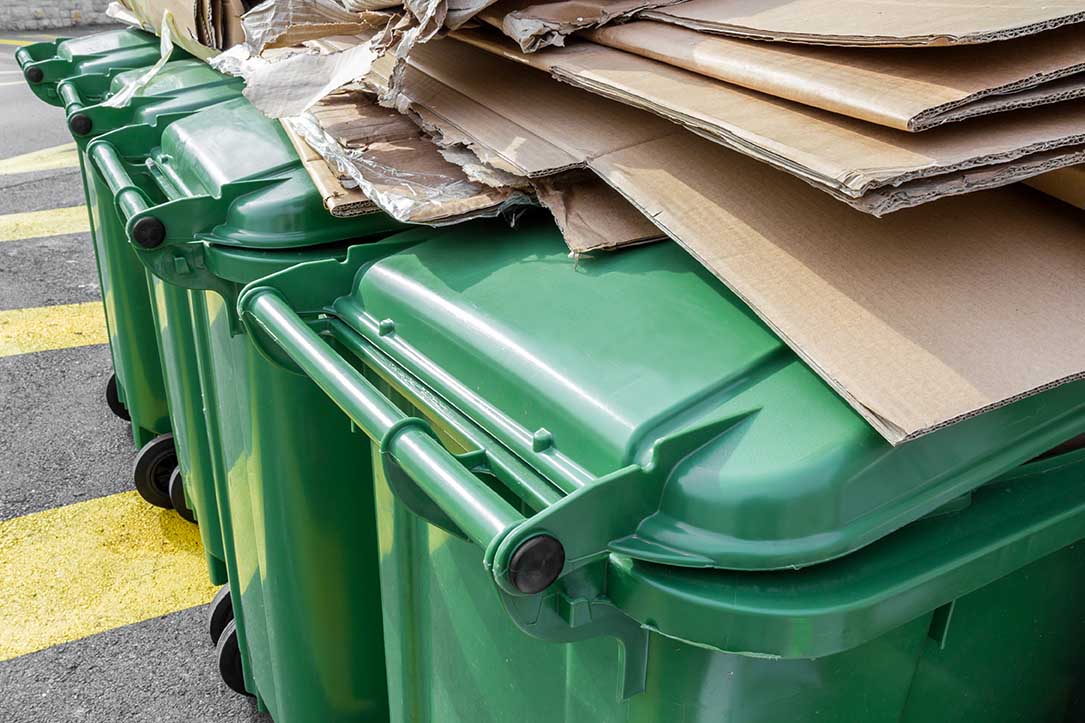
The industry group’s recycling rate now considers additional international trade data, allowing it to better capture imported material that ends up in the recycling stream. | Kyna Studio/Shutterstock
The American Forest & Paper Association has overhauled its methodology for calculating fiber recycling rates, bringing a significantly lower OCC recovery figure than the industry previously reported.
The 2023 U.S. paper recycling rate came in at a range of 65-69%, AF&PA announced during a Nov. 14 media briefing, and the OCC recycling rate came in at a range of 71-76%.
The rates were calculated using a new “supply-based” methodology that aims to capture the amount of material recycled out of the amount of that material that’s available for recycling, including imports. The previous methodology was “use-based,” looking specifically at the amount of paper recycled as a share of the amount of paper produced in the U.S., minus exports of new paper.
“Utilizing extensive industry data, subject matter expertise and detailed U.S. trade data, this updated methodology now reflects the amount of paper recycled as a share of the amount of paper available for recovery, rather than the share of the amount of paper used,” said Terry Webber, AF&PA’s vice president of industry affairs, during the press call.
Webber added AF&PA believes it is “the most thorough and fact based recycling rate possible,” and he said the changes “acknowledge the way U.S. consumers interact with our recycling system is changing, combined with rapidly evolving global supply chain and paper recovery markets.”
It represents a significant change for how the OCC recycling rate is calculated: In 2022, AF&PA reported an OCC recycling rate of 93%, or roughly 20 percentage points higher than its 2023 rate. For an apples-to-apples comparison, AF&PA recalculated the 2022 rate under its new methodology and found it was a range of 70-75%.
The paper recycling rate has remained closer to its value under the previous calculation. Under the old method, it was 68% in 2022, and recalculated, it is 62-66%.
Abigail Sztein, AF&PA’s executive director of recovered fiber, said during the press call that the new rates are reported as a range “to acknowledge aspects of the calculations that are based on estimates.”
One key change contributing to the OCC rate change is how imported material factors into the calculation. Sztein explained that “AF&PA has improved our estimate of net imported product packaging using more detailed trade data and better estimates for packaging dimensions.” The calculation will take into account both overseas and North American imports using the harmonized tariff schedule system for paper products, Sztein said.
That’s an important change: AF&PA openly acknowledged over the years that its OCC rate didn’t take into account boxes that enter the country holding imported goods, and that if it did, the rate would be lower. The group explained in a 2019 press release that “these particular boxes are not included in the OCC recovery for recycling rate calculation because there is no reliable data on their volume.”
The new calculation also sought to exclude paper that is not suitable for recovery from the equation, Sztein said.
“We deducted an estimate of materials in recovered paper bales that are not used in manufacturing; in other words, paper not suitable for use in the specific grade, non paper materials and net moisture,” she said.
For its AF&PA’s OCC recycling rate, “we made adjustments for cardboard and other paper-based consumer packaging in different grades of commodity bales,” Sztein said.
Change follows paper rate debate, and amid policy development
The change in AF&PA’s methodology comes after multiple alternative recycling rates for overall fiber and specifically OCC have been put forth over the last couple years, and it also comes amid a wider shift in how recycling data is reported.
In 2022, fiber industry analysts from Bloomberg Intelligence and Circular Ventures presented a case that the OCC recycling rate was 69%, far lower than the AF&PA’s calculation of 92% at that time. Bloomberg further revised that rate down for 2023, calculating a 66% OCC recycling rate. In a Resource Recycling article this year, Circular Ventures founder Myles Cohen expanded on the methodology he and Bloomberg’s Ryan Fox used to calculate their rate.
Late last year, a study from the National Renewable Energy Laboratory estimated the amount of landfilled fiber is far higher than what is reported by the U.S. EPA in its Facts & Figures report. NREL researchers estimated 62 million tons were landfilled in 2019, while the EPA estimated 16 million tons was landfilled in 2018. The different figures created a NREL paper recycling rate of 38%, lower than the 68% reported by the EPA in its most recent data release.
Finally, an EPA official recently said the agency is completely reworking how it calculates recycling rates for the Facts & Figures report. At an electronics recovery conference in October, EPA Office of Resource Conservation and Recovery Director Carolyn Hoskinson said the agency hadn’t taken a hard look at its methodology for a while, and that after its 2020 Facts & Figures report, “we basically found that our data was horrible.” A lot of the information was “very limited,” and sometimes even included data from one community, being extrapolated nationally.
All of that adds up to significant cross-sector momentum in rethinking how the paper recycling rate is calculated.
During the press call, AF&PA’s Webber added that “the benchmarks and definitions that are being set in regulation and policy” are also factoring into the methodology change.
As an example, one growing policy in the U.S. is extended producer responsibility for packaging, now approved by lawmakers in five states. In packaging EPR systems, when policymakers are thinking about recycling rates, “they are thinking about it as a percentage of total material available for recovery,” Webber said. In that way, AF&PA’s calculation closer aligns with how the industry will be benchmarked as these policies play out.